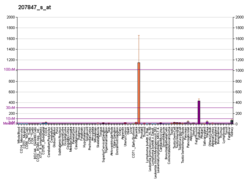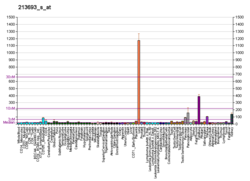Mucin-1 (MUC-1) is a heterodimer transmembrane protein of the mucin family encoded in humans by the MUC1 gene. It is cleaved into two chains: mucin-1 subunit alpha (MUC1-NT; MUC1-alpha) and mucin-1 subunit beta (MUC-CT; MUC1-beta). These subunits differ in size due to proteolytic cleavage of the translated precursor protein in the endoplasmic reticulum. The larger subunit of MUC-1 is characterized by numerous O-glycosylated bonds and a terminal sialic acid, creating a net negative charge on MUC-1. The smaller subunit contains a juxtamembrane region of the extracellular area, a transmembrane domain, and the cytoplasmic tail. The extracellular domain of MUC-1 is composed of 20 identical amino acid tandem repeats (TR). Each tandem repeat contains two serine and three threonine amino acid residues, providing five sites for potential O-glycosylation. MUC-1 protein is estimated to weigh 120 to 225 kDA.
The N-terminus of MUC-1 (MUC-1 N) contains variable number tandem repeats (VNTRs) of (PDTRPAPGSTAP PAHGVTSA). VNTR provides sites for glycosylation on proline, serine and threonine residues. The peptide backbone exhibits glycosidic bonds between serine and threonine within MUC-1 N. Within the cytoplasmic tail of MUC-1, multiple phosphorylation sites exist due to the presence of threonine, tyrosine and serine amino acid residues. Alterations to the cytoplasmic tail may affect movement through the Golgi apparatus, thus affecting glycosylation of the tandem repeat domains of MUC-1. The C-terminus of MUC-1 (MUC-1 C) is short—the majority of weight comes from N-glycosylation. Research has shown that the C-terminus is linked to the development of inflammation and cancer.
MUC-1 is located in the apical membrane on simple epithelial cell surfaces. These cells are found in the human kidney, gallbladder, stomach, lung, pancreas, mammary gland, and the female reproductive tract. MUC-1 is removed from the membrane by endocytosis, internalized, re-glycosylated and recycled to the cell membrane.
Function
O-glycosylation and N-glycosylation in MUC-1 contribute to the formation of mucin. MUC-1 is a transcriptional coactivator involved in the activity and stabilization of enzymes and transcription of metabolic functions. MUC-1 regulates tyrosine kinase signaling receptors, which promote synthesis of biosynthetic intermediates used in cell growth. In normal cells, the tandem repeats and cytoplasmic tail of MUC-1 are significant in the regulation and progression of metastatic cancer. Alterations to these areas have shown a propensity of metastasis and progression in comparison to unaltered MUC-1 domains.
MUC-1 has many functions. MUC-1 is an inhibitor for cell-to-cell extracellular interactions for both normal and malignant cells. The extracellular sperm protein–enterokinase–agarin (SEA) domain of MUC-1 contributes to a variety of functions including: inhibition of immune response, resistance to stimuli, and regulation of cell shedding. MUC-1 provides protection to the apical membrane to prevent rupture, as well as environmental and immune attack. MUC-1 has been shown to repair epithelia through the activation of epigenetic reprogramming, epithelial-mesenchymal transition and self-renewing (stemness) in maintaining epithelial cell homeostasis.
In cancer
MUC-1 is over expressed in many forms of cancer. Given, MUC-1 is 10 times higher in cancer cells than normal cells, an over expression of MUC-1 in cancer can be indicative of aggressive, metastatic cancer, having a low response to therapy and survival rate. MUC-1 also exhibits altered glycosylation and aberrant surface distribution patterns in tumor cells. Tumor related MUC-1 disrupts and inhibits cell-cell and cell-matrix interactions and adherence. Inhibition of cellular interactions diminishes the adherence of immune effector cells to malignant cells, thereby creating an immunosuppressive effect. MUC-1 in cancerous epithelial cells exhibits a loss of polarity. This loss of polarity creates incomplete carbohydrate side chains, allowing the formation of new abnormal side chains, thus increasing tumorigenesis. In normal cells, MUC-1 is isolated to the apical surface of the cell. In cancer cells, over expression of MUC-1 is seen throughout the cell's nucleus, plasma membrane and cytoplasm. In addition to the membranous isoform, an alternatively spliced mucin-1 is secreted extracellularly.

MUC-1 in cancer is underglycosylated, causing interactions to form between MUC-1 core protein, transmembrane receptors, and extracellular components. The intercellular interaction between MUC-1 and the receptor ICAM-1 facilitates endothelial and epithelial cell interactions, allowing circulating cancer cells to adhere in the inner lining of blood vessels and thus migrate. MUC-1 over expression is controlled through transcription changes, post-translational, and amplification modifications. In transcription, MUC-1 in cancer is regulated through STAT proteins, hormones, hypoxia, and growth factors. MUC-1 plays a role in the increase of the autophagy of mitochondria, a process called mitophagy. An increase in mitophagy triggers the development and progression of cancer.

Breast cancer
MUC-1 is shown to be over expressed in 90% of triple-negative breast cancer (TNBC). MUC-1 C increases the progression of TNBC. MUC-1 C chronically activates pro-inflammatory pathways in cancer cells. Triple-negative breast cancer stem cells rely on MUC-1 C for epithelial-mesenchymal transition, chromatin remodeling and epigenetic programming, which allow the cancer cells to avoid DNA damage and immune evasion. MUC-1 allows triple-negative breast cancer stem cells to engage in linear plasticity, a transition from one pathway into another, thus supporting the progression of TNBC. Recent studies have shown changes of MUC-1 family antigences (CA 15-3, CA 27.29 and MCA) in saliva in breast cancer patients. Downregulated MUC1 was associated with HER2(+), high Ki-67 and G II-III. It showed a statistically significant increase in the cytokines VEGF, IL-1β, IL-2, IL-4, IL-10, and IL-18 against the background of reduced hormonal levels of estrogen and progesterone. The changes occurring locally in the oral cavity reflect complex biochemical shifts in the reactivity of the immune system of the entire body. This is manifested in the suppression of the anti-inflammatory activity of MUC1 due to proinflammatory cytokines that have passed the hematosalivary barrier and are activated by oncogenic processes occurring in breast cancer. The suppression of the anti-inflammatory activity also occurs because of a deficiency of estrogens and progesterone, inhibiting the expression of MUC1 on the epithelial cells of the oral mucosa. This cascade of biochemical reactions occurs due to the aggressive nature of the oncological process in HER2(+) breast cancer.
Ovarian cancer
MUC-1 is over expressed in over 90% of all epithelial ovarian cancer. Currently, MUC-1 CT is being used to create therapies for ovarian cancer. Targeting MUC-1 CT to reduce expression has potential to control late-stage epithelial ovarian cancer. Since MUC-1 C does not contain a kinase or enzymatic function, targeting the protein's catalytic site is rendered useless. Research looking at breast cancer and MUC-1 showed promise in peptide blocking and disrupting MUC-1 CT interactions with specific effectors, decreasing proliferation, migration and invasion of metastatic breast cancer in vitro and inhibiting tumor growth and reoccurrence in mouse models. The results show promise for epithelial ovarian cancer therapies.
Cancer therapy
Studies have shown MUC-1 over expression creates drug resistance during chemotherapy by altering glycolytic metabolism. Over expression of MUC-1 decreases the apoptotic response to DNA damage, and increases anti-apoptotic Bcl-XL and PI3K/Akt pathways. MUC-1 in tumor cells suppresses mitochondria from releasing apoptotic factors, creating resistance to genotoxic anticancer agents. Cancer therapies are being developed to specifically target MUC-1 proteins, including peptide-based therapies, MUC-1 antibodies/conjugates, and MUC-1 vaccinations. Peptide-based therapies develop peptides that target tumors and attack membranes with a cytotoxic effect. Murine antibodies that are reactive with MUC-1 VNTR domain have been produced through immunization using milk fat globule membranes, isolated mucin preparations, and tumor cells. Developed MUC-1 monoclonal antibodies are used in diagnosis of cancer, and creation of target therapies.
References
- ^ GRCh38: Ensembl release 89: ENSG00000185499 – Ensembl, May 2017
- "Human PubMed Reference:". National Center for Biotechnology Information, U.S. National Library of Medicine.
- "UniProt". www.uniprot.org. Retrieved 7 November 2022.
- "MUC1 Gene - GeneCards | MUC1 Protein | MUC1 Antibody". www.genecards.org. Retrieved 7 November 2022.
- ^ Horm, Teresa M.; Schroeder, Joyce A. (2013-03-01). "MUC1 and metastatic cancer". Cell Adhesion & Migration. 7 (2): 187–198. doi:10.4161/cam.23131. ISSN 1933-6918. PMC 3954031. PMID 23303343.
- ^ Deng, Junli; Wang, Li; Chen, Hongmin; Li, Lei; Ma, Yiming; Ni, Jie; Li, Yong (2013-12-01). "The role of tumour-associated MUC1 in epithelial ovarian cancer metastasis and progression". Cancer and Metastasis Reviews. 32 (3): 535–551. doi:10.1007/s10555-013-9423-y. ISSN 1573-7233. PMID 23609751. S2CID 254384521.
- ^ Wang, Honghe; Lillehoj, Erik P.; Kim, K. Chul (2004-08-20). "MUC1 tyrosine phosphorylation activates the extracellular signal-regulated kinase". Biochemical and Biophysical Research Communications. 321 (2): 448–454. doi:10.1016/j.bbrc.2004.06.167. ISSN 0006-291X. PMID 15358196.
- ^ Brayman M, Thathiah A, Carson DD (January 2004). "MUC1: a multifunctional cell surface component of reproductive tissue epithelia". Reproductive Biology and Endocrinology. 2: 4. doi:10.1186/1477-7827-2-4. PMC 320498. PMID 14711375.
- Qing, Liangliang; Li, Qingchao; Dong, Zhilong (2022-11-01). "MUC1: An emerging target in cancer treatment and diagnosis". Bulletin du Cancer. 109 (11): 1202–1216. doi:10.1016/j.bulcan.2022.08.001. ISSN 0007-4551. PMID 36184332. S2CID 252649766.
- ^ Chen W, Zhang Z, Zhang S, Zhu P, Ko JK, Yung KK (June 2021). "MUC1: Structure, Function, and Clinic Application in Epithelial Cancers". International Journal of Molecular Sciences. 22 (12): 6567. doi:10.3390/ijms22126567. PMC 8234110. PMID 34207342.
- Nath S, Mukherjee P (June 2014). "MUC1: a multifaceted oncoprotein with a key role in cancer progression". Trends in Molecular Medicine. 20 (6): 332–342. doi:10.1016/j.molmed.2014.02.007. PMC 5500204. PMID 24667139.
- ^ Chen W, Zhang Z, Zhang S, Zhu P, Ko JK, Yung KK (June 2021). "MUC1: Structure, Function, and Clinic Application in Epithelial Cancers". International Journal of Molecular Sciences. 22 (12): 6567. doi:10.3390/ijms22126567. PMC 8234110. PMID 34207342.
- Altschuler Y, Kinlough CL, Poland PA, Bruns JB, Apodaca G, Weisz OA, Hughey RP (2000). "Clathrin-mediated Endocytosis of MUC1 Is Modulated by Its Glycosylation State". Molecular Biology of the Cell. 11 (3): 819–831. doi:10.1091/mbc.11.3.819. PMC 14813. PMID 10712502.
- ^ Mehla K, Singh PK (April 2014). "MUC1: a novel metabolic master regulator". Biochimica et Biophysica Acta (BBA) - Reviews on Cancer. 1845 (2): 126–135. doi:10.1016/j.bbcan.2014.01.001. PMC 4045475. PMID 24418575.
- ^ Li Q, Chu Y, Li S, Yu L, Deng H, Liao C, et al. (October 2022). "The oncoprotein MUC1 facilitates breast cancer progression by promoting Pink1-dependent mitophagy via ATAD3A destabilization". Cell Death & Disease. 13 (10): 899. doi:10.1038/s41419-022-05345-z. PMC 9606306. PMID 36289190.
- Bose M, Mukherjee P (November 2020). "Potential of Anti-MUC1 Antibodies as a Targeted Therapy for Gastrointestinal Cancers". Vaccines. 8 (4): 659. doi:10.3390/vaccines8040659. PMC 7712407. PMID 33167508.
- Baruch A, Hartmann M, Yoeli M, Adereth Y, Greenstein S, Stadler Y, Skornik Y, Zaretsky J, Smorodinsky NI, Keydar I, Wreschner DH (1999). "The breast cancer-associated MUC1 gene generates both a receptor and its cognate binding protein". Cancer Research. 59 (7): 1552–1561. PMID 10197628. S2CID 25997699.
- ^ Yamashita N, Kufe D (July 2022). "Addiction of Cancer Stem Cells to MUC1-C in Triple-Negative Breast Cancer Progression". International Journal of Molecular Sciences. 23 (15): 8219. doi:10.3390/ijms23158219. PMC 9331006. PMID 35897789.
- Dyachenko, Elena I.; Bel’skaya, Lyudmila V. (January 2024). "Salivary Transmembrane Mucins of the MUC1 Family (CA 15-3, CA 27.29, MCA) in Breast Cancer: The Effect of Human Epidermal Growth Factor Receptor 2 (HER2)". Cancers. 16 (20): 3461. doi:10.3390/cancers16203461. ISSN 2072-6694. PMC 11506585. Retrieved 31 October 2024.
 This article incorporates text from this source, which is available under the CC BY 4.0 license.
This article incorporates text from this source, which is available under the CC BY 4.0 license.
- Boohaker, R. J.; Lee, M. W.; Vishnubhotla, P.; Perez, J. L. M.; Khaled, A. R. (2012). "The Use of Therapeutic Peptides to Target and to Kill Cancer Cells". Current Medicinal Chemistry. 19 (22): 3794–3804. doi:10.2174/092986712801661004. PMC 4537071. PMID 22725698.
This protein-related article is a stub. You can help Misplaced Pages by expanding it. |





